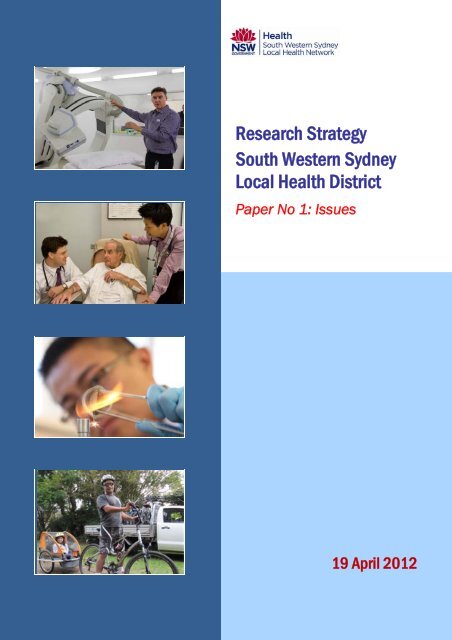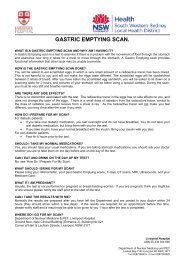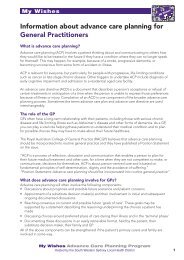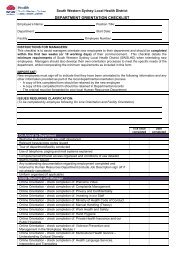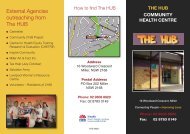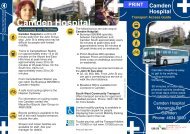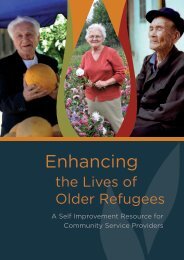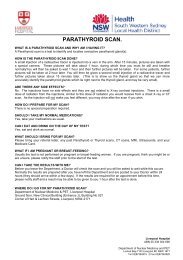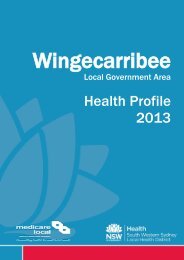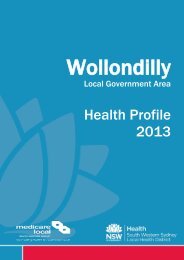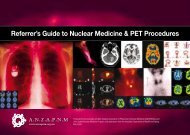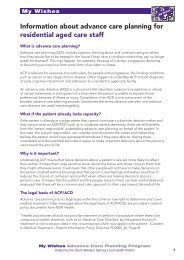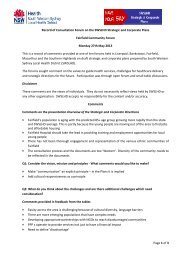Issues Paper - South Western Sydney Local Health District - NSW ...
Issues Paper - South Western Sydney Local Health District - NSW ...
Issues Paper - South Western Sydney Local Health District - NSW ...
You also want an ePaper? Increase the reach of your titles
YUMPU automatically turns print PDFs into web optimized ePapers that Google loves.
A Research Strategy for <strong>South</strong> <strong>Western</strong> <strong>Sydney</strong> <strong>Local</strong> <strong>Health</strong> <strong>District</strong> – <strong>Paper</strong> No.1 <strong>Issues</strong> Final April 2012Leadership and Direction1. SWSLHD Research Leadership, Profile and Research EthosResearch leadership within <strong>South</strong> <strong>Western</strong> <strong>Sydney</strong> has grown from the teaching hospitalstatus of Bankstown-Lidcombe and Liverpool hospitals. It gained considerable momentum inthe 1990’s with collaborative partnerships with the University of New <strong>South</strong> Wales (U<strong>NSW</strong>)which funded research units such as the Centre for <strong>Health</strong> Equity Training Research andEvaluation (CHETRE) and University of <strong>Western</strong> <strong>Sydney</strong> (UWS) that funded the Centre forApplied Nursing Research (CANR); the commitment of local clinicians; and the commitmentand financial support of local companies and communities.The Research Strategy for SSWAHS (<strong>Western</strong> Zone) 2006 to 2011 set the broad strategicresearch direction for the last five years with its focus on increasing research capacity,strengthening performance, creating an enhanced profile, and sustaining commitment ofmanagers, clinicians and other personnel to the research effort. Major successes of theStrategy have been:• The establishment of the Ingham Institute for Applied Medical Research, one of the<strong>NSW</strong> Government’s biomedical research hubs. It has a functioning Board andcommittee structure and was the recipient of $49 million for the development ofresearch facilities. It attracts significant community support and the on-going supportof the Ingham family and there is an active partnership with U<strong>NSW</strong> and UWS.• The development of the Ingham Institute Building, a Clinical Skills and SimulationCentre and Research Radiation Oncology Bunker with its MRI coupled linearaccelerator (due for completion in 2012), funded through grants from the AustralianGovernment, U<strong>NSW</strong>, the Radiotherapy Trust Fund and UWS.• The appointment of a Director of Clinical Trials funded through the Ingham Institute toincrease capabilities in the conduct of clinical trials for the entire <strong>District</strong>.• An expansion of research design and analysis capacity through the appointment of abiostatistician.• The creation of an internal grants program with four infrastructure grants of $200,000each provided to encourage collaborations into stronger more competitive researchenterprises. Four collaborations have been funded: the Allied <strong>Health</strong> group atBankstown; Cardiology at Liverpool Hospital; Early Years researchers; and communityhealth researchers working with CHETRE. In addition, a Grant Preparation Scheme wasestablished to provide small grants to assist those who submit NHMRC applications.• Development of the seven research streams of Cancer, Cardiovascular Disease,Community & Population <strong>Health</strong>, Early Years, Infectious & Inflammatory Diseases,Injury and Mental <strong>Health</strong>. These streams reflect the broad priorities of <strong>District</strong> research.• Appointment of a Research Director for the Ingham Institute and SWSLHD whoprovides oversight and direction to the research effort in SWSLHD and ensuresstrategic directions are achieved.• In the last three years, increased funding and grants for research projects (excludingcapital grants) and over the last five years a strengthening of innovative and essentialresearch in fields such as Aboriginal early years, cancer, and environmental health.SWSLHD| 6
A Research Strategy for <strong>South</strong> <strong>Western</strong> <strong>Sydney</strong> <strong>Local</strong> <strong>Health</strong> <strong>District</strong> – <strong>Paper</strong> No.1 <strong>Issues</strong> Final April 2012• Annual and targeted research forums which provide opportunities for showcasinglocal health research, networking and discussing new findings.The achievements in leadership place SWSLHD in a strategic position to capitalise on the<strong>NSW</strong> Research Review recommendations. However the consultations with clinicians,managers and staff identified that there is no consistent message about the importance ofresearch from the Board down. This is reflected by the variability across facilities, services andprofessions in the amount of research conducted, the financial and other supports providedand expectations for accountability and reporting. For example some services incorporateresearch and research based practice into the duties of all staff whereas other services seeresearch as outside their role. In addition to the efforts to establish the Ingham Institute, thedecision by the SWSLHD Board to establish a Research and Education Subcommittee is animportant initiative however the need for ongoing concerted leadership for research from anexecutive level (Board, Chief Executive, <strong>District</strong> and Facility and Clinical Leaders) was seen ascritical for developing a research culture. Lack of accountability will maintain the existingethos and for this reason reporting on research performance is also seen to be essential.The need for the <strong>District</strong> to develop a strong research profile within <strong>NSW</strong>, nationally andinternationally was seen as essential for attracting and retaining high level researchers.However the deficits in infrastructure (physical assets, systems and people) meant that the<strong>District</strong>s research profile was not high. As one researcher expressed it “<strong>South</strong> <strong>Western</strong> <strong>Sydney</strong>is seen as a good source of research participants, however staff are not routinely credited forinvolvement in externally lead research and without this recognition, our researchers are lesslikely to be successful in grant applications”. Leadership will therefore not only require a clearmessage but also action.Some senior medical staff proposed research qualifications/experience as a prerequisite forsenior positions. While this may be feasible for medicine particularly as hospitals furtherdevelop their teaching role, it may not be easily achievable for nursing and allied healthprofessionals who have not had the same tradition or opportunities for further education.Summary of issuesLHD needs a strong research profile to attract and retain high quality staffImportance of research needs to be consistently recognised in LHD facilities.The number of staff with research qualifications needs to be increased.More research activity should be initiated or directly involve staff from the LHD2. The Relationship between SWSLHD and the Ingham InstituteAlthough originally incorporated under the control of the former <strong>Sydney</strong> <strong>South</strong> West Area<strong>Health</strong> Service (SSWAHS), the Ingham Institute for Applied Medical Research was establishedas an independent legal entity with its own Board of Directors and Executive managementteam in late 2008. Despite its independent status, there are numerous interdependencies inthe roles and functions of the Institute and SWSLHN.There was a lack of consensus regarding the future role of the Institute within the <strong>District</strong>.While some clinicians/researchers argued that the Institute should be the main vehicle for<strong>District</strong> research and management, others indicated that they could see stronger separationin the longer term. This raises fundamental questions regarding their respective roles andfunctions in research direction, communication with external bodies, performancemonitoring and reporting, and promotion and fund raising. It also raised questions about howSWSLHD| 7
A Research Strategy for <strong>South</strong> <strong>Western</strong> <strong>Sydney</strong> <strong>Local</strong> <strong>Health</strong> <strong>District</strong> – <strong>Paper</strong> No.1 <strong>Issues</strong> Final April 2012conflicts of interest and ownership of intellectual property should be addressed. The currentarrangement is a practical solution in the short - medium term however in the longer term thespecific roles of each entity and their relationship require clarification.Within this context, the future direction of the Institute is an issue. Services which are lessmedically oriented e.g. population health, nursing and allied health were concerned thatthe inclusion of “applied medical research” in the Ingham Institute’s name suggested that“non-medical” research would not meet the future mandate of the Institute and wouldtherefore not be funded or supported in the future. The development of new researchinstitutes on other hospital campuses or addressing other health priorities was raised. Theviability of establishing new institutes with their underlying infrastructure costs, andreduplication of effort and time within the life of this Research Strategy is questionable.Summary of issuesThe relationship of the Ingham Institute to research in SWSLHD needs to be betterdefined3. Advanced <strong>Health</strong> Research CentresThe NHMRC Discussion <strong>Paper</strong> - Developing Advanced <strong>Health</strong> Research Centres in Australia(2010) proposes the development of Advanced <strong>Health</strong> Research Centres (AHRC) whereconsortia of universities, medical research institutes and hospitals apply formally forrecognition of their excellence in research and research translation. AHRC’s seek to promoteexcellence in health and medical research where clinical care is provided, encouragecollaboration between researchers, promote the translation of research into clinicalpractice, day to day care of patients and training in research for health professionals,develop innovative models of care and ensure efficient use of research facilities. These aimsare underpinned by collaborations where there is sharing of infrastructure.Liverpool Hospital is one of eight identified research hubs in <strong>NSW</strong> and together with theIngham Institute and existing relationships with universities (particularly the University of New<strong>South</strong> Wales and <strong>Western</strong> <strong>Sydney</strong>) could develop as an Advanced <strong>Health</strong> Research Centre.While there was support for building relationships with the universities to improve access toresearch expertise and resources, there was less support for an AHRC as a priority directionfor SWSLHD at this stage. Overseas experience suggests that responsibility and accountabilitymechanisms need to be clearly established to make it work and without guaranteedadditional funding, there is the potential that a focus on an AHRC at this stage may divertattention from other strategic imperatives.Summary of issuesAdvanced <strong>Health</strong> Research Centres are in early development and their final formand value are uncertain.Priority Setting and Innovation1. Research StreamsResearch streams help define broad areas of research that external funders and thecommunity can relate to. Research streams also create an imperative for strategic visionamong researchers and should give rise to economies of scale. The development ofresearch streams was seen by many as a significant strength of the <strong>District</strong>, enabling aSWSLHD| 8
A Research Strategy for <strong>South</strong> <strong>Western</strong> <strong>Sydney</strong> <strong>Local</strong> <strong>Health</strong> <strong>District</strong> – <strong>Paper</strong> No.1 <strong>Issues</strong> Final April 2012broader cross section of disciplines, research units and services to address collaborativelypriority research questions and to provide a base from which workforce capability can bedeveloped. Streams were also seen to provide an environment where research could beembedded into clinical practice. This strength is reflected in the new and innovativeresearch that is being undertaken in the <strong>District</strong>.The <strong>NSW</strong> <strong>Health</strong> Review Discussion <strong>Paper</strong> (October 2011) has identified that in the futureresearch priorities will need to be clearly identified. Although the research streams reflect theoverarching broad <strong>District</strong> priorities, the research priorities and directions within each streamhave not been as clearly articulated. This limits the streams’ ability to develop projects withgreatest potential to attract funds, impact on the health of the community, change clinicalpractice and engage with and support new researchers/ clinicians in developing theirresearch skills and expertise. It also limits the ability of the <strong>District</strong> and Ingham Institute toidentify where research support (in the form of direct or indirect funding) is required andwhich areas of research would provide the greatest benefit to the local community.Summary of issuesThe function, strategies and relationships of research streams need support andleadership.The number of streams should be limited but will not define all of the researchundertaken in the LHD or in the Ingham InstituteThe relationship between the Ingham research streams and LHD research and clinicalservices needs to be defined.Should research streams be limited to disease entities or reflect professional groupingssuch as Allied <strong>Health</strong> or Nursing?2. Potential Research PrioritiesThe following indicates some issues critical to potential research directions.<strong>Health</strong> Behaviours and ConditionsA stronger approach to prevention was seen by a number of staff as an area which couldbe further developed. Currently, population health research is targeting areas such assmoking (particularly in Aboriginal communities), environment and mental health. This workoccurs in partnership with other agencies including <strong>NSW</strong> Departments of Housing, Planningand Education and local councils. In addition, it is planned that SWSLHD will host the new<strong>NSW</strong> Office of Prevention, providing additional knowledge and expertise locally which canfurther support research into prevention.The following are examples of potential areas of research for SWSLHD investment:The growth of obesity and overweight nationally, and particularly in <strong>South</strong> <strong>Western</strong><strong>Sydney</strong>, and its impact on a range of health conditions suggest that there may bebenefits in developing a new and stronger prevention agenda in overweight andobesity to prevent diabetes and related health problems.Injury is a potential area for expansion due to its broad interdisciplinary agenda, theimpact of life-time disability and broader base of research funding options.Research into models of care in prevention, early intervention and treatment ofHepatitis B and related liver carcinomas is important given the large non-Englishspeaking communities in this <strong>District</strong>.SWSLHD| 9
A Research Strategy for <strong>South</strong> <strong>Western</strong> <strong>Sydney</strong> <strong>Local</strong> <strong>Health</strong> <strong>District</strong> – <strong>Paper</strong> No.1 <strong>Issues</strong> Final April 2012Antibiotic stewardship to ensure cost-effective therapy and improve patientoutcomes while containing bacterial resistance.These areas need funding to build on and develop leadership and attract high levelresearchers.Summary of issuesSWSLHD has developed considerable expertise in working in partnership with otheragencies to address major health problems. The new Office of Prevention to belocated in this <strong>District</strong> will offer opportunities to build on existing research.Emerging health problems such as obesity, Hepatitis B and injury require greaterattention.Aboriginal PeopleThe policy initiative “Closing the Gap”, adopted by all levels of government, is an importantinitiative in addressing the poorer health outcomes experienced by Aboriginal People. Thoseconsulted indicated that the <strong>District</strong> is well placed (via its partnerships) to improve the healthof the Aboriginal community, with priority given to prevention, health services andtranslational research. Building on strong partnerships with the Tharawal Aboriginal MedicalService and Marumali, important research which builds national knowledge is beingundertaken by services such as Community <strong>Health</strong>, Mental <strong>Health</strong>, <strong>Health</strong> Promotion andCHETRE in the health and development of Aboriginal children in their early years (inCampbelltown), smoking and diabetes.Aboriginal people indicated that they were “over-researched”, with poor translation ofresearch into practice and limited impact on health outcomes. If health outcomes are toimprove, research to inform models of prevention and health care are urgently required.Further where models of and approaches to care (such as service flexibility, holistic care,working through local GP services, and engaging the community through schools) havebeen evaluated as improving outcomes for Aboriginal people they are rarely translated intoclinical practice by mainstream services. Variable attention to true partnerships whichinvolve Aboriginal people in research identification and design, and limited evaluation andfeedback about projects are seen however to inhibit ongoing and future participation inresearch.Potential areas for research identified by Aboriginal services and staff include: translationalresearch using models which are shown to improve Aboriginal health; researching serviceeffectiveness and building evaluation of health outcomes for Aboriginal people (rather thanjust outputs) into all health services; building on GP related research occurring in Aboriginaland non-Aboriginal practices; considering the impact of colonisation and forced separationof families on health; improving care planning; and the contribution of institutional racismand career development (capacity building and structure) to Aboriginal employment andburnout.Summary of issuesAboriginal people are “over-researched” with poor translation of research intopractice or limited impact on health outcomes.Potential areas for research include: translational research using models that areknown to improve health outcomes for Aboriginal people; a stronger focus on serviceSWSLHD| 10
A Research Strategy for <strong>South</strong> <strong>Western</strong> <strong>Sydney</strong> <strong>Local</strong> <strong>Health</strong> <strong>District</strong> – <strong>Paper</strong> No.1 <strong>Issues</strong> Final April 2012effectiveness; building on GP related research; the impact of colonisation and forcedseparation of families on health; and care planning.People from Culturally and Linguistically Diverse (CALD) CommunitiesThere are pockets of CALD research in the <strong>District</strong> covering research topics such as refugeehealth, violence, and specific health treatment e.g. orthopaedics. However despite the sizeof the CALD communities, concerns were expressed that clinical research often excludespeople who do not speak English (usually citing interpreter costs), limiting the pool ofresearch candidates and potentially restricting generalisation of findings across all residents.In addition, little attention is given to communities with health problems at rates higher thanthe <strong>NSW</strong> average. Inadequate consideration of cultural factors such as literacy, communityinexperience with research and concerns about confidentially further inhibit participation.Belated involvement of multicultural expertise and insufficient consideration of communityexpectations were also seen to impact on future involvement in research and relationshipswith service providers.<strong>Health</strong> professionals have recognised for decades that health care for people from CALDbackgrounds requires additional effort and resourcing. A strategic concern for this <strong>District</strong> isthat activity based funding does not adequately consider these additional costs. It is in the<strong>District</strong>’s interest to undertake health services research to identify how health care to thesecommunities can be provided efficiently into the future.It also in the <strong>District</strong>’s interest to focus more strongly on those health conditions which are atlevels above the state-average given their potential to substantially increase demand forhospital based services. It also creates the potential to develop commercial and populationapproaches to address specific health problems in countries of origin.Summary of issuesCALD patients need better access to clinical trialsResearch should focus on mitigating health inequalitiesSignificant Socio-Economically Disadvantaged CommunitiesTraditionally, clinical research has been undertaken with people who can comply withclinical protocols. Lower educational attainment, poor health literacy (i.e. in understandingcomplex information and the health system) and reduced capacity to meet the costs ofparticipation in research (e.g. parking, transport, child/respite care and leave from work) canimpact negatively on the successful engagement of the community.Population <strong>Health</strong>, Mental <strong>Health</strong> and Community <strong>Health</strong> (and related research units) havesignificant expertise in working with disadvantaged communities, usually in collaboration withother government and non-government agencies. A collaborative approach in preventionand service provision in meeting the needs of complex and complicated families isfundamental to <strong>NSW</strong> government direction. Ensuring that our future research includes thesecommunities and supports targeted research will strengthen research outcomes.Summary of issues Collaborative research in prevention and intervention with disadvantagedcommunities and complex families needs to continueSWSLHD| 11
A Research Strategy for <strong>South</strong> <strong>Western</strong> <strong>Sydney</strong> <strong>Local</strong> <strong>Health</strong> <strong>District</strong> – <strong>Paper</strong> No.1 <strong>Issues</strong> Final April 2012Age of the population<strong>South</strong> <strong>Western</strong> <strong>Sydney</strong> has the second largest number of births of any <strong>District</strong> in <strong>NSW</strong> and anumerically large child and youth profile. The strong focus on early years research andinnovation in paediatric care lends itself to addressing national, state and local priorities.There is also a significant aged population (approximately 98,089 people in 2011) expectedto grow by 48% over the next ten years and by 80% by 2026.The clinical streams of Maternity and Womens <strong>Health</strong>, and Aged Care and RehabilitationServices identified a need for stronger leadership and financial support in developingresearch capacity. Most clinical specialties will be affected by these burgeoning populationsand there are significant opportunities for collaborative research in evaluating new modelsof care and service programs. With the redevelopment of Liverpool and Campbelltownhospitals, there is also an opportunity to explore the impact of health building designparticularly on older people.Summary of issuesSignificant growth and ageing in the local population will drive the need forevaluation of and research into existing and new models of care.3. Evolving Partnerships and DevelopmentsThe University of <strong>NSW</strong> has contributed significant investment in academic staff and researchon the Liverpool, Bankstown and Fairfield campuses. This is likely to continue withopportunities through the Advanced <strong>Health</strong> Research Centres to develop common researchinfrastructure such as tissue banking and biostatistical services. U<strong>NSW</strong> Grant ManagementOffice provides grant review and management services.The development of Campbelltown Hospital as a Principle Referral Hospital by 2021 and theprincipal campus of the University of <strong>Western</strong> <strong>Sydney</strong> Clinical School within Macarthurprovides a unique opportunity to recruit stronger clinical and research expertise to the <strong>District</strong>and to develop new areas of research in priority areas e.g. innovative models of maternityand paediatric care, and care partnerships with other agencies.Over the next ten years it is anticipated that there will be a range of models of care, agencyrelationships and funding arrangements which will change and develop. Some of theseinitiatives such as specialist surgical centres have already been identified in <strong>NSW</strong>Government and Australian Government plans. In other cases the changes may be drivenby clinicians and services in <strong>South</strong> <strong>Western</strong> <strong>Sydney</strong>. These developments provide furtheropportunities for research.An initiative of the Australian Government has been the establishment of Medicare <strong>Local</strong>s toreplace Divisions of General Practice. The new <strong>South</strong> <strong>Western</strong> <strong>Sydney</strong> Medicare <strong>Local</strong>(SWSML) will commence operation in June 2012 and will have an expanded responsibilityand broader coverage of the private health suppliers than previously. It will also share thesame boundaries as the <strong>District</strong>. The <strong>District</strong> is working with the new SWSML in developing amore strategic approach to health care. There are significant opportunities for increasingcollaboration between primary and secondary care researchers in translational and healthservices research, building on capacity building work of the simulation centre and in usingthe electronic Practice Based Research Network (ePBRN) developed by the U<strong>NSW</strong>/SWSLHNGeneral Practice Unit.SWSLHD| 12
A Research Strategy for <strong>South</strong> <strong>Western</strong> <strong>Sydney</strong> <strong>Local</strong> <strong>Health</strong> <strong>District</strong> – <strong>Paper</strong> No.1 <strong>Issues</strong> Final April 2012The <strong>South</strong> West Growth Centre (SWGC) covering Liverpool, Camden and CampbelltownLGAs is a major <strong>NSW</strong> urban development with a projected population of 300,000 people by2025. In collaboration with the local Divisions of General Practice, a model for future healthservice provision has been identified. The model proposes Team General Practices andPrimary <strong>Health</strong> Care Clinics servicing smaller populations, and Integrated Primary <strong>Health</strong> andCommunity Care Centres (with potential to offer a wider range of ambulatory care services)serving very large populations. This model will drive new approaches to primary health andcommunity based care and infrastructure developments in the SWGC.As a collaboration between SWSLHD, the SWSML and universities, this is an important area forresearch into developing research culture and ethos, and for evaluating alternative ways ofproviding, managing, operating and integrating primary and community care.The new Ingham Institute building will provide a central focus for health research in <strong>Sydney</strong>’s<strong>South</strong> West. Liverpool Hospital has two other developments of importance. The ResearchRadiation Oncology Bunker will enable clinical researchers to vastly improve patienttreatment in cancer patients treated for tumours and will place Liverpool at the centre ofworld’s best practice for radiation treatment across many different cancer types. The ClinicalSkills and Simulation Centre will support the practical interaction between desk andlaboratory, clinical practice, and public health policy by providing state of the art trainingand facilities for clinicians, nurses, allied health professionals and students.Summary of issuesAustralian and <strong>NSW</strong> government initiatives such as Medicare <strong>Local</strong>s, urbandevelopment in the <strong>South</strong> West Growth Centre, redevelopment of CampbelltownHospital and development of the Ingham Institute offer unique opportunities for newpartnerships and areas of research.Building Research Capability1. Management of ResearchThe SWSLHD workforce is hardworking and committed to the community in which they serve.The lack of dedicated time for research (and workload pressures created by populationgrowth, growing service demand and insufficient resources) and other supports (e.g. clericalstaff) were identified by senior researchers and staff as the most significant barrier forresearch. Many reported that research occurred outside normal working hours and/orprevented participation in research. These same pressures also create a culture whereresearch was not supported by managers or by other staff.Not all staff will have the skills, interest in or desire to lead health research however it isbroadly recognised that health services and staff should contribute to research to improvehealth and health care. Towards this end, there was considerable support for incorporatingresearch into the roles of staff and implementing polices which ensuring that dedicated timewas allocated for research.Summary of issuesThe lack of dedicated time for research and workload pressuresThe lack of research supports such as data management, IT and statisticsSWSLHD| 13
A Research Strategy for <strong>South</strong> <strong>Western</strong> <strong>Sydney</strong> <strong>Local</strong> <strong>Health</strong> <strong>District</strong> – <strong>Paper</strong> No.1 <strong>Issues</strong> Final April 2012A culture where research was not supported by managers or by other staffA lack of skills, interest or desire to do research2. Specialist Research SupportThere is a range of expertise which is fundamental to effective research design,development and evaluation. The <strong>District</strong> has pockets of research expertise provided byresearch units such as the General Practice Unit at Fairfield; the Centre for Research,Evidence Management and Surveillance; the Centre for Applied Nursing Research; Centrefor <strong>Health</strong> Equity Training Research and Evaluation; and Centre for Population Mental <strong>Health</strong>Research. In addition to their research, these units foster and support research initiated orundertaken by staff and students. <strong>Local</strong> medical libraries also provide advice and supportto researchers in literature searches, and in some cases actually undertake a search.Other research services essential to the conduct of research are either not available or oflimited availability. For example, many researchers and staff welcomed the recentappointment through the Ingham Institute of a part-time biostatistician but indicated that theposition only partially meets local requirements. There is no expertise in the <strong>District</strong> fortelephone and written survey design and researchers frequently need to outsource theirstatistical work to universities knowing that this work is not a priority and will take longer.A number of clinicians, services and staff indicated that there was a need for generalresearch support such as data managers and research coordinators. The provision of smallgrants in the past was seen by some researchers as a very useful strategy for buildingresearch however for others it produced variable outcomes. The recent award of largerinfrastructure grants by the Ingham Institute has allowed some clinicians to significantlyincrease their research capacity. The availability of large scale funding in the future from theIngham Institute is questionable given ongoing research projects.A major gap identified is the lack of a single coordination function within the <strong>District</strong> forproviding information and advice about research supports, priorities, expertise and outputs.The Ingham Institute has been fulfilling some of this role e.g. producing an annual reporthowever the broader coordination and information role is outside of its mandate.Summary of issuesThe lack of research supports such as data management, IT and statisticsFunding for small grants, early career research support and support for mid-careerresearchersNeed for a single coordination office within LHD to provide advice and report onresearch activity3. Clinical TrialsA clinical trial is research in which a therapeutic, preventive or diagnostic intervention istested on human subjects. Although primarily used in the evaluation of drugs or medicaldevices, this methodology can also be used in health service delivery evaluation and result inimproved health care and population health outcomes and longer term benefitseconomically. The size and diversity of its population make SWSLHD a prime area for clinicaltrials and there are an increasing number of services conducting trials (including multicentreSWSLHD| 14
A Research Strategy for <strong>South</strong> <strong>Western</strong> <strong>Sydney</strong> <strong>Local</strong> <strong>Health</strong> <strong>District</strong> – <strong>Paper</strong> No.1 <strong>Issues</strong> Final April 2012studies) in areas such as COPD, paediatrics, cancer, obstetrics and gynaecology andorthopaedics.The recent appointment of a part-time Clinical Trials director (and statistician mentionedabove) through the Ingham Institute are important actions to strengthen trial leadership anddirection in clinical trials. However while clinicians and researchers have the capability toexpand trials, the historical gaps in coordination and lack of core infrastructure havehampered this work and require urgent attention. While some of these problems arecommon to all researchers, some are specific to clinical trials. In addition to the dearth ofbiostatistical expertise, randomisation services are outsourced; clinical trial pharmacists (andstaff and systems for drug invoicing) are unavailable or funded on an adhoc basis; there areno standard operating procedures to manage risk and inform proper practice; andindemnity arrangements do not align with community care arrangements. Induction andmandatory training in Good Clinical Practice (GCP) consistent with the InternationalConference on Harmonisation (ICH) is also not available and mentorship is adhoc.The <strong>South</strong> <strong>Western</strong> Area Pathology Service (SWAPS) provides pathology services to researchon a cost recovery basis (where appropriate). Although the proposed amalgamation of all<strong>NSW</strong> pathology services into a single <strong>NSW</strong> entity may support the strategic development ofresearch pathology services. However currently SWAPS has variable capacity, space andequipment to significantly increase its support to research and research pathologyarrangements (including cost recovery) require review and updating. An added concern isthe lack of research specific policies and systems in tissue sampling, management (includingdispatch), cataloguing and long term storage of research samples.Clinical trials nurses/coordinators face additional barriers with difficulty in gaining approval(and funding) to attend mandatory training, trial meetings and conferences; inadequatesalaries associated with inflexible award application; and “red tape” in ensuring practicalsupport to patients e.g. free on-site parking.Specific issues identified in Ethics governance include delays in processing ethicsapplications which have resulted in the loss of pharmaceutical industry funding, the lack ofclinical trial pharmacy expertise on the Ethics Committee and in site specific assessments;and the increasing workload associated with adverse event reporting requirements.The potential to undertake health services research, using clinical trials methodology, in areassuch as aged care, community care and mental health where the range of models ofservice are expanding are prime areas of research growth and development.Summary of issuesStatistics and pharmacy are unavailable or funded on an ad hoc basisThere are a range of clinical trial policy and processes which require development.This includes research pathology systems and processesClinical trials assistants have difficulty undertaking standard parts of their rolerequirements such as travel to investigator meetingsEthics governance has caused severe delays resulting in the loss of pharmaceuticalindustry sponsored trials.SWSLHD| 15
A Research Strategy for <strong>South</strong> <strong>Western</strong> <strong>Sydney</strong> <strong>Local</strong> <strong>Health</strong> <strong>District</strong> – <strong>Paper</strong> No.1 <strong>Issues</strong> Final April 2012Building Workforce Capacity1. The Research WorkforceResearchers in the <strong>District</strong> have a wide range of skills and interests and include senior “elite”researchers with internationally recognised research, mid-career researchers and new andemerging researchers. Some concerns were common to researchers at all levels includingthe limited career and salary structure and lack of permanency.<strong>District</strong> research units and some researchers receive financial support from the <strong>District</strong> in theform of a contribution to salaries and goods and services and services in kind (including thecost of administering research grants applied as an on-cost). The consultation identifiedvariable levels of financial support for existing experienced researchers and limited capacity(and flexibility) to attract new elite researchers into priority areas. There was support for thedevelopment of financial and other incentives to attract and retain high level researchers i.e.by targeting recruitment to <strong>District</strong> research priorities and developing a new pool of funds(and other incentives) to provide researchers with essential support. Examples include acontribution to recurrent costs to cover salaries and wages and/or maintaining relatively lowon-cost charges for grant administration.The need to develop and grow our own researchers in a coordinated and planned mannerwas identified by most researchers and managers. It was noted that mid-career researchersgo overseas to further their research careers due to a lack of positions and other supports.Creation of research fellowships locally was seen as a means to retain emerging expertise.For those interested in research and new researchers, the support is variable. Medical librariesconduct courses in information retrieval and documentation e.g. CIAP and Endnote andresearch units such as CANR and CHETRE have a formal role in capacity building. However:there are no formal education programs covering basic research or methodologye.g. Good Clinical Practice (GCP), research design, statistical methods, etc. As aresult staff attend courses outside the <strong>District</strong>, often at their own cost.Unlike the <strong>District</strong>’s Management Trainee programs, there is no financial support fromthe <strong>District</strong> provided to employees undertaking post-graduate degrees by research.In fact this has been formally discouraged and some employees undertake researchdegrees in their own time.there are no formal broadly based mentoring or supervision programs for new andemerging researchers or ways to enable interested staff to contribute to largerprojects.There was considerable support for developing basic and mandatory research educationprograms, establishing scholarships to enable staff to complete research based postgraduatedegrees and developing mentoring programs. The Centre for Education andWorkforce Development (CEWD) plays a pivotal role in developing the skills of staff andcould play an important role in coordinating research education programs in partnershipwith universities and providing guidance around mentoring programs.There was also support for developing conjoint appointments with affiliated universities as away of strengthening research networks and improving access to specific resources such asjournals and programs available within universities.SWSLHD| 16
A Research Strategy for <strong>South</strong> <strong>Western</strong> <strong>Sydney</strong> <strong>Local</strong> <strong>Health</strong> <strong>District</strong> – <strong>Paper</strong> No.1 <strong>Issues</strong> Final April 20122. Nursing and Allied <strong>Health</strong> ResearchIn an environment of limited resources, SWSLHD staff work collaboratively across healthdisciplines (and with other agencies) in developing new and innovative approaches tohealth care and prevention. Further development of this approach in research could occurthrough the development stream priorities which included interdisciplinary research andstronger networking arrangementsThere is a long history in medicine of academic endeavour (including education andresearch in clinical settings) which is reflected the medical professional structure and awardconditions. In contrast, developments in nursing and allied health university basedundergraduate and graduate education and professional awards which recognise researchexpertise are relatively more recent.There is one nursing professorial position in the <strong>District</strong> based within the Centre for AppliedNursing Research (CANR). CANR is seen as a major nursing strength enabling the <strong>District</strong> andUniversity of <strong>Western</strong> <strong>Sydney</strong> to work collaboratively to support nurses and midwives inundertaking clinical and health research. It has a well developed track record in systematicreviews and evidenced based practices, the development of nursing and multidisciplinarypolicies and clinical guidelines, and building the capacity of nurses to undertake research.Specific issues for nurses and midwives in research were: the lack of an academic base andresearch experience which prevents nursing-led research; exclusion of nurses from aspects ofinterdisciplinary research design, analysis and write-up (and non-recognition of theircontribution to research); Clinical Nurse Consultants (CNCs) with clinical expertise but almostno post graduate qualifications in research, reducing their capacity to undertake research orto support others; and difficulty in gaining release from clinical workloads.Clinical trial nurses have additional hurdles in obtaining funding and release to attendmandatory interstate or overseas research training, investigator led meetings, andconferences. The lack of a career structure and permanency has resulted in some nursesleaving the <strong>District</strong>.The issues were slightly different for allied health professionals. Although these staff undertakeresearch in undergraduate courses, there is limited practical support to become researchactive in the workplace. Funding is somewhat fragmented with a dedicated researchposition at the Liverpool Hospital Brain Injury Unit and a two year Ingham’s InstituteInfrastructure Grant at Bankstown-Lidcombe Hospital for allied health research. This fundinghas netted increased research outputs in targeted areas however long term sustainedsupport for allied health research (such as that provided to CANR) is not funded. There is apaucity of academic career opportunities in Allied <strong>Health</strong> in the LHD.Clinical based research by both professions also appears to be less visible and/or is poorlyrecognised. Further financial support to attend and/or present at conferences is variable.Noting the dominance of medical research, there was considerable support by nursing andallied health researchers for targeted scholarships similar to that available in Queensland.There was also support for a dedicated research position/Chair in Allied <strong>Health</strong> Research andfor structures/networks to support research in nursing and allied health clinical practice.SWSLHD| 17
A Research Strategy for <strong>South</strong> <strong>Western</strong> <strong>Sydney</strong> <strong>Local</strong> <strong>Health</strong> <strong>District</strong> – <strong>Paper</strong> No.1 <strong>Issues</strong> Final April 2012Summary of issuesNursingthe lack of an academic base and research experience;exclusion of nurses from aspects of interdisciplinary research design, analysis andwrite-up (and non-recognition of their contribution to research);Clinical Nurse Consultants (CNCs) with clinical expertise but almost no postgraduate qualifications in research, reducing their capacity to undertakeresearch or to support others; anddifficulty in gaining release from clinical workloads.Allied <strong>Health</strong>limited practical support to become research active in the workplacelack of academic leadership.3. Community EngagementEngagement of the community in the various forms of research can make or break successin a research project. The size of the <strong>South</strong> <strong>Western</strong> <strong>Sydney</strong> population and its diversity(cultural, linguistic and socio-economic) was identified as a major strength by researchersand staff. Perversely the implications of this diversity for research e.g. poor literacy, limitedfinancial capacity, and lack of previous exposure to research were not always considered inproject identification and design or in research participants’ support.<strong>Local</strong> communities are seen to be “generous ....and want to help others in the samesituation” however there were barriers to increasing community engagement in research:Poor understanding in all communities of the various types of research and its valueLiteracy levels and the dominance of participant information and forms using complexlanguage and concepts provided only in writing or English. Ethics Committeerequirements were perceived to increase these problems.Need for greater thought about the impact of participation on the private lives of peopleby recompensing participation (via movie passes or vouchers or promoting altruisticconcepts such as “helping the next generation” ), providing financial support e.g.outreach, free parking, cab charges, food and having streamlined administrativeprocesses (e.g. approvals). Lack of attention to people from other cultures starting at project design (refer to Issue 5).The pathway into research for consumers i.e. timing and place of recruitment (e.g.preadmission clinics, at discharge or in outpatient, GP or community settings), orprecursors e.g. helping in education of students which could lead into research.Clinician communication style, language and approach used to engage patients andfamilies in research including issues on side effects, confidentiality and privacy.SWSLHD| 18
A Research Strategy for <strong>South</strong> <strong>Western</strong> <strong>Sydney</strong> <strong>Local</strong> <strong>Health</strong> <strong>District</strong> – <strong>Paper</strong> No.1 <strong>Issues</strong> Final April 2012The importance of feedback to individuals and communities i.e. the outcome, benefit topatients and the broader community.Building on SWSLHD Community/Consumer networks, consumers indicated that there may bebenefits in involving them in research design and explaining research to potentialparticipants.Summary of issuesThere are significant barriers to community participation in research in SWSLHDincluding research literacy, language and culture.4. Ethics and Research GovernanceThe SWSLHD Ethics and Research Governance Office is responsible for administeringsubmissions to the SWSLHD Human Research Ethics Committee and providing advice andinformation about research ethics and human research governance policies.Although research volume (i.e. nationally funded studies and clinical trials) in SWSLHD hassignificantly increased, resourcing of the Office does not reflect demand. Researchersidentified considerable delays in processing and following up applications, placing grants,trials and student research at risk. In addition, the new ethics staff have not yet developedthe relationships and educational programs essential to support researchers.In 2007, <strong>NSW</strong> implemented a system of single ethical & scientific review of multi-centreresearch to ensure that it is only ethically reviewed once. Under this system, Lead <strong>Health</strong>Research Ethics Committees (HREC) are accredited to undertake a single review on behalfof all sites in the public health system. Unfortunately, the SWSLHD HREC is not an accreditedLead HREC because it lacked sufficient staff and may only review research undertakenwithin the <strong>District</strong>. As a result, SWSLHD applications for large multisite research have to be sentto an external accredited Lead HREC for approval. Site Specific Applications (SSA’s) requiredfor all research occurring in SWSLHD are a problem with multiple levels of signoff (by SWSLHDclinical and non-clinical services e.g. medical records) before approval can be given.Differing expectations, variability in procedures and variation in forms increases confusion,duplication and the likelihood of error or omission and makes the ethical approval processarduous. Differing understanding by managers of their delegation can mean that an SSAmay be rejected by a facility on ethical grounds even though approved by a HREC.The Australian Research Ethics Database (AU RED) is used to manage all National EthicsApplication Forms (NEAF) and Site Specific Applications (SSA). Although useful for clinicaltrials, it does not meet the Ethics Office requirements for other work which require Ethicalconsideration e.g. quality assurance. Low risk studies are reviewed under the separate lowrisk framework by subcommittees of the HREC.There was considerable support for increasing resourcing to the Office and in developingeducation and training for researchers and the Ethics Committee.Summary of issuesThe Research and Ethics Office is under resourced to meet the requirements to be alead ethics committeeSSA processes are time-consuming and variable.SWSLHD| 19
A Research Strategy for <strong>South</strong> <strong>Western</strong> <strong>Sydney</strong> <strong>Local</strong> <strong>Health</strong> <strong>District</strong> – <strong>Paper</strong> No.1 <strong>Issues</strong> Final April 2012Infrastructure EnablersSWSLHD services such as the Information Management and Technology Division (IMTD),Human Resources, Capital Works and Finance play an important role in providing the systemsand infrastructure needed to support research activity. The consultation indentified a rangeof areas where a more concerted focus is required.1. Physical Assets for ResearchResearch assets such as offices, wet labs, equipment, clinical rooms and research storageareas are located predominantly in Liverpool (e.g. the Clinical Services Building, the mainhospital building and Speed Street) and to a lesser extent in other facilities. The new InghamInstitute building, Cancer Research Bunker with MRI and Skills Simulation Centre providemuch needed new infrastructure to expand research capability.Access to clinical space, office and storage for research purposes is an issue in all facilities.Recent capital planning for Liverpool and Campbelltown hospitals has attempted to takeinto account the needs of research to access clinical rooms however the stageddevelopment of these facilities suggests that access (at least in the medium term) may bedifficult. Demand created by a growing and ageing population will place additionaldemands on clinical space and equipment. Adequate accommodation for research activityis required in all major facilities.2. Financial ManagementThe financial management of research projects is complex with considerable diversity infunding sources (i.e. government, non-government, special purpose and trust (SP&T),pharmaceutical and philanthropic), grants and partnership arrangements, and variability inprocesses for payment, reporting and accountability.The <strong>District</strong> Finance Department is developing new systems and processes such as electronicordering and timely cost centre reporting to improve financial management. This shouldaddress some of the concerns identified in financial management of research however thereis also a need for clearer processes for project identification and grant management(including acquittal and end of project management), improved understanding aboutfinancial arrangements with research partners and funders and better costing methods fordetermining the financial viability of research.3. Human ResourcesEfficient human resource processes are particularly important for enabling research to meettimeframes and ensuring that experienced staff are recruited and retained. The need for aresearch career structure with flexibility in employment and pathways to permanency,variable understanding of research requirements by middle and senior management (suchas the need for clinical research credentialing), and delays in recruitment and conferenceleave (and related) approvals were identified as areas which required additional attention.There are no specific awards applicable to researchers, particularly ‘dry’ researchers whoare often employed as ‘<strong>Health</strong> Service Managers’. This creates difficulties with grading,recruitment and promotion.SWSLHD| 20
A Research Strategy for <strong>South</strong> <strong>Western</strong> <strong>Sydney</strong> <strong>Local</strong> <strong>Health</strong> <strong>District</strong> – <strong>Paper</strong> No.1 <strong>Issues</strong> Final April 20124. Information ManagementThe Information Management & Technology Division (IM&TD) provides technicalinfrastructure which improves information flow and links clinical information. The progressiverollout of the CERNER electronic medical record (eMR) and other functionalities, access tothe <strong>Health</strong> Information Exchange and increased capacity to videoconference are importantnew developments. Concerns identified by researchers focused on data governance e.g.operation of data bases which do not interface with CERNER, poor use of the eMR researchcapabilities, the cost of purchasing research statistical software and fire-wall barriersbetween the <strong>District</strong> and universities (which restrict communication and access to universityresources).Summary of issuesResearch in SWSLHD requires greater support from infrastructure enablers such as IT,human resources and finance if it is to thrive.Implementation and Measuring ProgressAs noted in the policy context of this paper, the funding of health research under the COAGagreement is still unclear with lack of agreement about how to measure researchperformance. The collection of information about performance will be particularly importantfor <strong>District</strong>s such as SWSLHD which have an emerging research role.Currently information about research affiliated with the Ingham’s Institute is collected by theInstitute however this excludes research undertaken with other universities or institutes. Whilesome services e.g. Brain Injury Unit collect detailed qualitative and quantitative informationabout research outputs, there are no performance within performance agreements.As part of this strategy, it will be important that SWSLHD develops systems for measuringoutputs and monitoring and evaluating the effectiveness of strategies.Summary of issuesImplementation will need to be monitored and performance indicators developed toassess progress.SWSLHD| 21
A Research Strategy for <strong>South</strong> <strong>Western</strong> <strong>Sydney</strong> <strong>Local</strong> <strong>Health</strong> <strong>District</strong> – <strong>Paper</strong> No.1 <strong>Issues</strong> Final April 2012ReferencesCommonwealth of Australia A National <strong>Health</strong> and Hospitals Network for Australia's Future,Canberra 2010Department of Innovation Industry Science and Research Strategic Roadmap for AustralianResearch Infrastructure, Australian Government Canberra 2011Commonwealth of Australia Strategic Review of <strong>Health</strong> and National Research in Australia,Website, http://www.mckeonreview.org.au/ (accessed 24 February 2011)<strong>NSW</strong> Ministry of <strong>Health</strong> <strong>NSW</strong> <strong>Health</strong> and Medical Research Strategic Review Discussion <strong>Paper</strong>31 October 2011, <strong>NSW</strong> Ministry of <strong>Health</strong> <strong>Sydney</strong> 2011National <strong>Health</strong> and Medical Research Council Discussion <strong>Paper</strong> - Developing Advanced<strong>Health</strong> Research Centres in Australia, Australian Government Canberra 2010SWSLHD| 22


